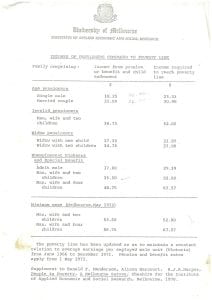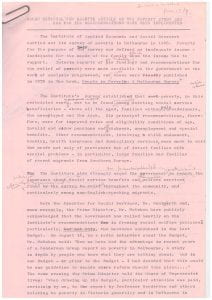The Henderson Poverty Report: ‘The First of its Kind’
Yichen Wang, Elizabeth Sim, Chante Mullins, & Megan Grove
The archives relating to the Henderson Poverty Report provide not only an insight into early theorisations of poverty, but also a frozen-in-time snapshot of the style of media coverage, research methods, and socio-political discourse in 1970s Australia. These archives also invite reflection on the rigorous organisation and coordination needed for data collection before the advent of modern technology.
The first of its kind in Australia, the Henderson Poverty Report emerged from the premise that to address poverty one needed first to identify who was poor and the conditions engendering it. The report identified the key demographic groups where poverty was most prevalent. These included families with no male heads and large families with four or more dependent children. From there, it recommended an increase in social service payments.
Those directing the Henderson Poverty Report encountered great difficulties in engaging members of the public at random to take part in the study. It was a similar story when it came to finding volunteers to conduct the research. Included in the research papers is a job advertisement for interviewers, as well as a thank you note, personally signed by Ronald F. Henderson, addressed to participants in the study. One health survey located in these archives noted the difficulties in data collection, stating: “the time factor by which we are bound actually precludes spending too much time on transference of facts”.

Of particular interest to us was a report accompanying the Henderson Poverty Report. Conducted by the University of Melbourne’s Institute of Applied Economic and Social Research in the 1970s, this piece of research opened by establishing four categories: “age pensioners”, “invalid pensioners”, “widow pensioners” and “unemployment sickness and special benefit”. These categories were then connected to two other categories – the income each group received; “from pension or benefit and child endowment”, and the “income required to reach the poverty line”. The result was concerning. Many pensioners were earning well below the poverty line. Sadly, despite the passage of time, the plight of pensioners has scarcely improved.
The Henderson Poverty Report also documented the living circumstances of another demographic – people with disabilities. The data revealed that those with disabilities fell below or just above the poverty line in far greater numbers than those without disabilities. Elderly people with disabilities faced the greatest difficulties, followed by those belonging to families with no male head, and large families. One thing to note about this study is its interesting definition of disability. In contrast to today, where ‘disability’ generally refers to the loss of physical or mental function, the report widens this, classifying recent migrants and those with low skills as disabled. While use of the term ‘disabled’ in this manner might be considered inappropriate by some, it does nevertheless allow for a broader conception of those social groups in need of greater assistance.

Running through the Henderson Poverty Report is a desire to improve living standards in Australia. Ronald F. Henderson elaborated on this aim in a draft report titled ‘Poverty’. In this report, Henderson outlined his ambitious belief that due to the small proportion of poverty in an affluent country like Australia we could afford to abolish it. As with the Henderson Poverty Report itself, the ‘Poverty’ report details measurements and examples of experiences of poverty in Australia during this period. Overall, there is an emphasis placed on continuing this work and strengthening Australia’s responses to poverty. As Henderson concluded: “we hope we have started something”. Unfortunately, the spirit underlying the Henderson Poverty Report has evaporated in the years since its publication.
Leave a Reply